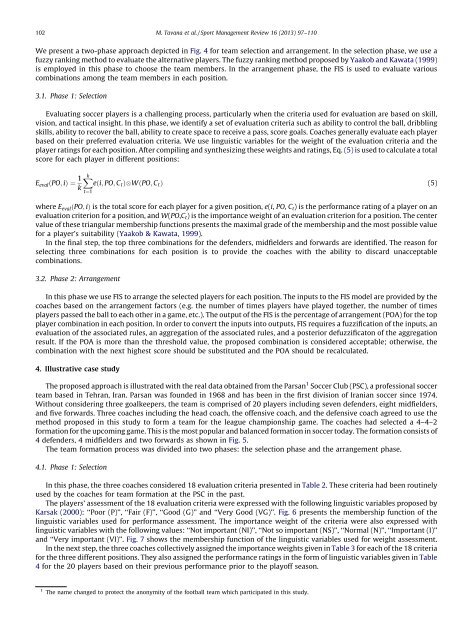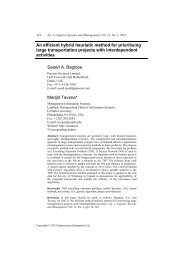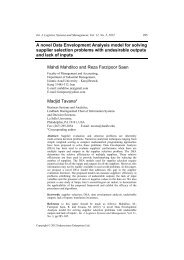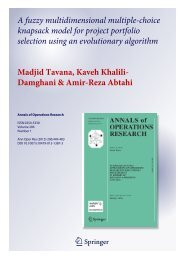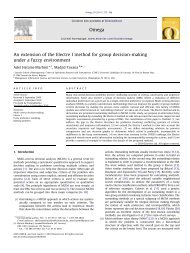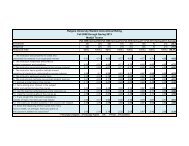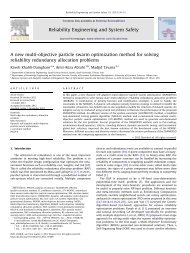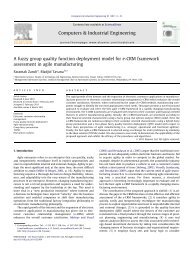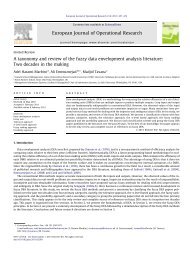A fuzzy inference system with application to player selection and ...
A fuzzy inference system with application to player selection and ...
A fuzzy inference system with application to player selection and ...
Create successful ePaper yourself
Turn your PDF publications into a flip-book with our unique Google optimized e-Paper software.
102M. Tavana et al. / Sport Management Review 16 (2013) 97–110We present a two-phase approach depicted in Fig. 4 for team <strong>selection</strong> <strong>and</strong> arrangement. In the <strong>selection</strong> phase, we use a<strong>fuzzy</strong> ranking method <strong>to</strong> evaluate the alternative <strong>player</strong>s. The <strong>fuzzy</strong> ranking method proposed by Yaakob <strong>and</strong> Kawata (1999)is employed in this phase <strong>to</strong> choose the team members. In the arrangement phase, the FIS is used <strong>to</strong> evaluate variouscombinations among the team members in each position.3.1. Phase 1: SelectionEvaluating soccer <strong>player</strong>s is a challenging process, particularly when the criteria used for evaluation are based on skill,vision, <strong>and</strong> tactical insight. In this phase, we identify a set of evaluation criteria such as ability <strong>to</strong> control the ball, dribblingskills, ability <strong>to</strong> recover the ball, ability <strong>to</strong> create space <strong>to</strong> receive a pass, score goals. Coaches generally evaluate each <strong>player</strong>based on their preferred evaluation criteria. We use linguistic variables for the weight of the evaluation criteria <strong>and</strong> the<strong>player</strong> ratings for each position. After compiling <strong>and</strong> synthesizing these weights <strong>and</strong> ratings, Eq. (5) is used <strong>to</strong> calculate a <strong>to</strong>talscore for each <strong>player</strong> in different positions:E eval ðPO; iÞ ¼ 1 kX kt¼1eði; PO; C t ÞWðPO; C t Þ (5)where E eval ðPO; iÞ is the <strong>to</strong>tal score for each <strong>player</strong> for a given position, e(i, PO, C t ) is the performance rating of a <strong>player</strong> on anevaluation criterion for a position, <strong>and</strong> W(PO,C t ) is the importance weight of an evaluation criterion for a position. The centervalue of these triangular membership functions presents the maximal grade of the membership <strong>and</strong> the most possible valuefor a <strong>player</strong>’s suitability (Yaakob & Kawata, 1999).In the final step, the <strong>to</strong>p three combinations for the defenders, midfielders <strong>and</strong> forwards are identified. The reason forselecting three combinations for each position is <strong>to</strong> provide the coaches <strong>with</strong> the ability <strong>to</strong> discard unacceptablecombinations.3.2. Phase 2: ArrangementIn this phase we use FIS <strong>to</strong> arrange the selected <strong>player</strong>s for each position. The inputs <strong>to</strong> the FIS model are provided by thecoaches based on the arrangement fac<strong>to</strong>rs (e.g. the number of times <strong>player</strong>s have played <strong>to</strong>gether, the number of times<strong>player</strong>s passed the ball <strong>to</strong> each other in a game, etc.). The output of the FIS is the percentage of arrangement (POA) for the <strong>to</strong>p<strong>player</strong> combination in each position. In order <strong>to</strong> convert the inputs in<strong>to</strong> outputs, FIS requires a fuzzification of the inputs, anevaluation of the associated rules, an aggregation of the associated rules, <strong>and</strong> a posterior defuzzifica<strong>to</strong>n of the aggregationresult. If the POA is more than the threshold value, the proposed combination is considered acceptable; otherwise, thecombination <strong>with</strong> the next highest score should be substituted <strong>and</strong> the POA should be recalculated.4. Illustrative case studyThe proposed approach is illustrated <strong>with</strong> the real data obtained from the Parsan 1 Soccer Club (PSC), a professional soccerteam based in Tehran, Iran. Parsan was founded in 1968 <strong>and</strong> has been in the first division of Iranian soccer since 1974.Without considering three goalkeepers, the team is comprised of 20 <strong>player</strong>s including seven defenders, eight midfielders,<strong>and</strong> five forwards. Three coaches including the head coach, the offensive coach, <strong>and</strong> the defensive coach agreed <strong>to</strong> use themethod proposed in this study <strong>to</strong> form a team for the league championship game. The coaches had selected a 4–4–2formation for the upcoming game. This is the most popular <strong>and</strong> balanced formation in soccer <strong>to</strong>day. The formation consists of4 defenders, 4 midfielders <strong>and</strong> two forwards as shown in Fig. 5.The team formation process was divided in<strong>to</strong> two phases: the <strong>selection</strong> phase <strong>and</strong> the arrangement phase.4.1. Phase 1: SelectionIn this phase, the three coaches considered 18 evaluation criteria presented in Table 2. These criteria had been routinelyused by the coaches for team formation at the PSC in the past.The <strong>player</strong>s’ assessment of the 18 evaluation criteria were expressed <strong>with</strong> the following linguistic variables proposed byKarsak (2000): ‘‘Poor (P)’’, ‘‘Fair (F)’’, ‘‘Good (G)’’ <strong>and</strong> ‘‘Very Good (VG)’’. Fig. 6 presents the membership function of thelinguistic variables used for performance assessment. The importance weight of the criteria were also expressed <strong>with</strong>linguistic variables <strong>with</strong> the following values: ‘‘Not important (NI)’’, ‘‘Not so important (NS)’’, ‘‘Normal (N)’’, ‘‘Important (I)’’<strong>and</strong> ‘‘Very important (VI)’’. Fig. 7 shows the membership function of the linguistic variables used for weight assessment.In the next step, the three coaches collectively assigned the importance weights given in Table 3 for each of the 18 criteriafor the three different positions. They also assigned the performance ratings in the form of linguistic variables given in Table4 for the 20 <strong>player</strong>s based on their previous performance prior <strong>to</strong> the playoff season.1 The name changed <strong>to</strong> protect the anonymity of the football team which participated in this study.


